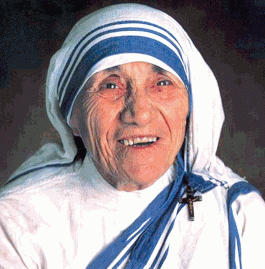Mother Teresa of Calcutta, the renowned and beloved Catholic nun and founder of the religious order, the Missionaries of Charity, was recently canonized a saint of the Catholic

Church. This means that Pope Francis declared, through an infallible statement, that Mother Teresa is in heaven with God, and she is worthy of our veneration.
The honoring of saints is such a beautiful part of the Catholic faith, but it is also a practice that is greatly misunderstood. Firstly, the notion that Catholics worship or adore the saints and the Blessed Virgin Mary should be dismissed. Worship and adoration are only for God. However, we do venerate, honor, and pray to the saints and to Mary for their intercession as we believe that their prayers are powerful with God. Think of it in earthly terms as when someone asks a trusted friend or colleague to speak on his or her behalf to someone else–that is what the saints do. They are our advocates and our friends, who are already enjoying eternal life with God; moreover, they are models for us of sanctity and faith.
Secondly, as we keep pictures and mementos of our loved ones, living and deceased, so Catholics keep pictures, statues, etc. of the saints. I have heard the saints referred to as “our elder brothers and sisters in the faith.” They are deeply interested in our well-being and our salvation.
Often saints are named patrons of specific causes, places, groups of people, etc. because they are somehow associated with that particular saint. However, the saints are not limited to their patron causes, and we can pray to them about or for anyone or anything.
So how does one become a saint? Well, every person who makes it to heaven is a saint, but to be a publicly canonized saint requires a declaration by the Church. Though as I recently heard explained during Mother Teresa’s canonization, the Catholic Church does not “make” saints. The canonization is a confirmation of the person’s holiness. Before this formal confirmation, a thorough and lengthy investigation into the person’s life takes place. Interviews are conducted with those who favor the person and with those who were critics of the person. It must be shown that the potential saint exhibited “heroic virtue and holiness of life.” Moreover, two miracles wrought through the person’s intercession since their death are also required–one prior to beatification or being declared “blessed,” the step immediately before sainthood, and then a second before canonization. Both theologians and scientists are involved in the investigations. These miracles must be determined to have no scientific explanation.
The whole process of inquiry is a painstaking, years-long process, which shows just how important the Church considers its declaration.
Even though popular opinion considered Mother Teresa a saint while she was still living, it is certainly a moment for rejoicing and thanksgiving now that she is officially a canonized saint of the Church. In his homily during the Mass of Canonization for Mother Teresa, Pope Francis said, “Mother Teresa, in all aspects of her life, was a generous dispenser of divine mercy, making herself available for everyone through her welcome and defence of human life, those unborn and those abandoned and discarded. … She bowed down before those who were spent, left to die on the side of the road, seeing in them their God-given dignity. … Mother Teresa loved to say, ‘Perhaps I don’t speak their language, but I can smile.’ Let us carry her smile in our hearts and give it to those whom we meet along our journey, especially those who suffer. ”
If you are curious to know more about the saints, you can learn about the saint whose feast or memorial it is each day at http:// www.catholic.org/saints/sofd.php. Mother Teresa’s feast day is Sept. 5th, the day that she died.
St. Teresa of Calcutta, pray for us!
